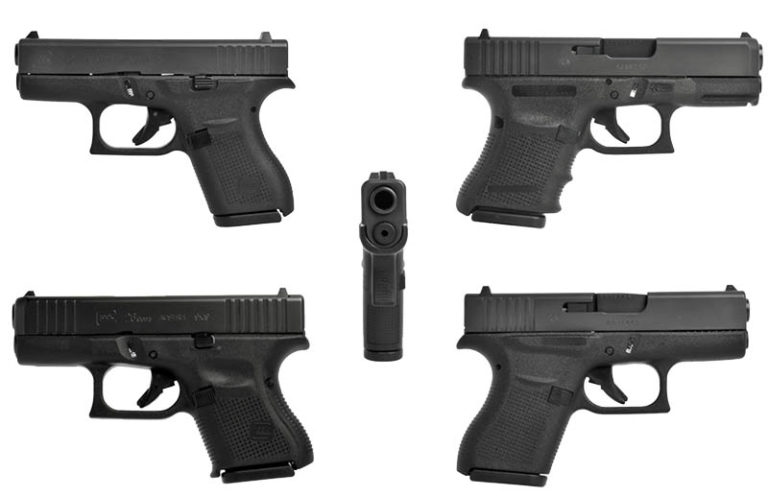
Baby Glock pistols are some of the most popular concealed carry guns on the planet, the only trouble is picking which model is best for you.
In this guide, we're going to discuss every subcompact model that could be considered a baby Glock. We’ll look at what those models are, what each one is good at and which one might be the best choice for particular applications. We'll also talk about their strengths and weaknesses compared to similar pistols from other manufacturers.
The Baby Glock Is Born
The first “Baby Glock” was the Glock 26, a 10-shot 9mm that was first introduced around 1995.
The Glock 27 (in .40 S&W) followed soon after, as well as the Glock 28—a blowback variant of the G26 chambered in .380. However, the G28 has never been widely available in the US due to the 1968 Gun Control Act’s import restrictions on certain kinds of pistols.
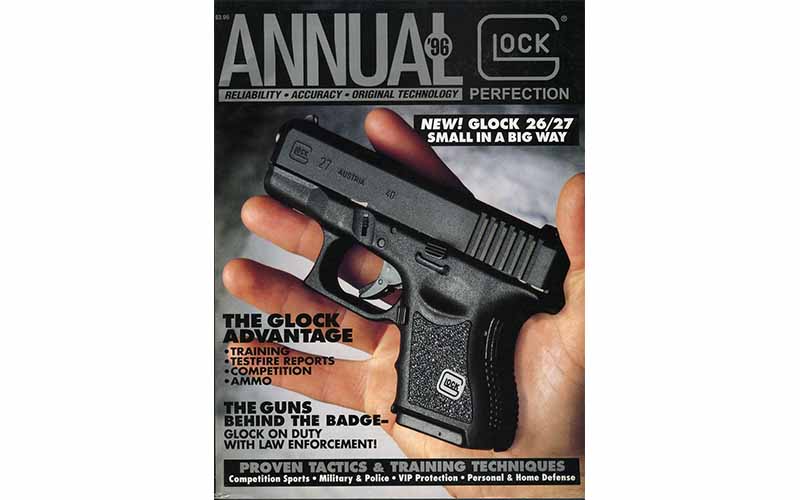
The Glock 29 and 30, double-stack subcompacts chambered in 10mm and .45 ACP respectively, were also released in 1997. These pistols likewise had a 10-round standard capacity.
These initial “Baby Glock” models quickly became popular as backup guns and as plainclothes/off-duty weapons for police, and quickly gained traction with the nascent US concealed carry market as well. The subcompact Glocks released since then have been tailored to the changing needs and desires of concealed carriers.
Guide To Baby Glock Models
9mm Subcompact Glocks
Glock 26
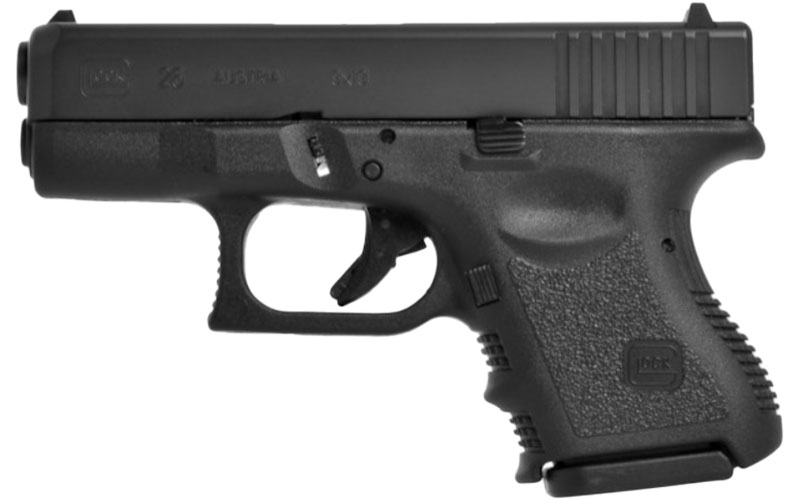
The Glock 26 is a double-stack subcompact with a 3.4-inch barrel, and arguably the most popular baby Glock. It's available on the commercial market in Glock's Gen 3 or Gen 5 configurations as well as in Gen 4 for law enforcement. Regardless of the generation, all have a 10+1 standard capacity with flush-fit mags. But like all Glocks, they can accept extended magazines too. The G26 is only offered with iron sights from the factory, however, as no MOS version is available.
Glock 43
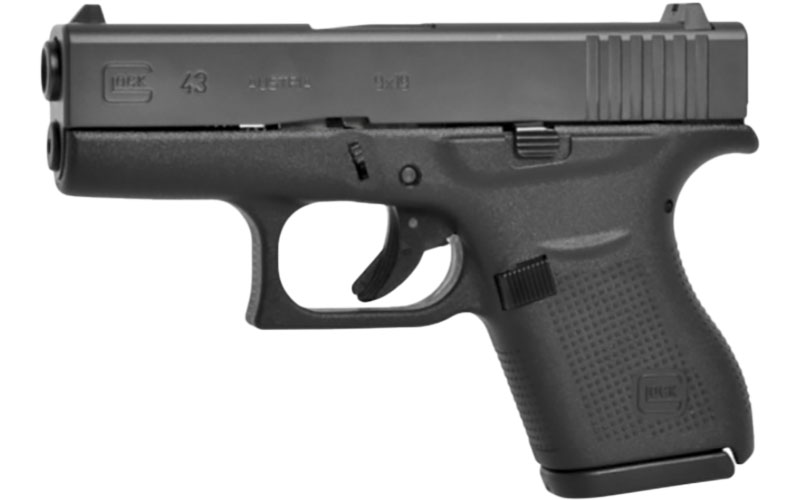
The Glock 43, first released in 2012, is a single-stack subcompact with a 6+1 capacity and a 3.41-inch barrel. The introduction of single-stack magazines allowed for a much slimmer overall profile, giving it an edge in both comfort and concealability.
Glock 43X
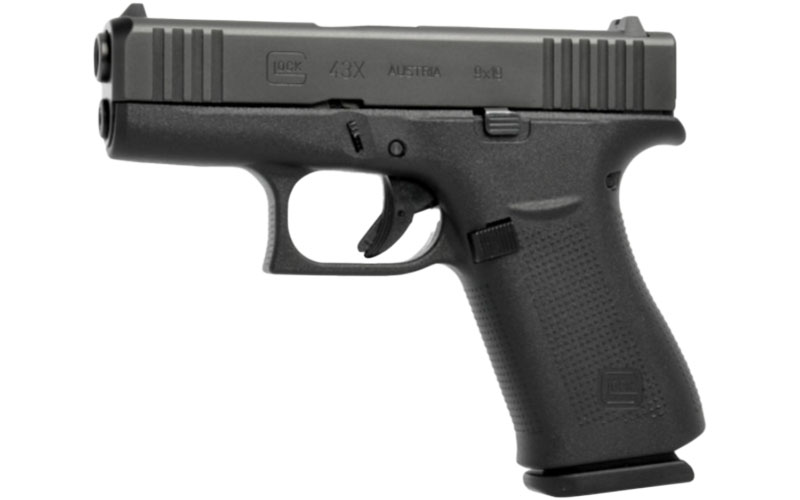
In 2019, Glock released the 43X as part of their Slimline series, first in a silver two-tone finish but later in all-black as well. The Glock 43X uses the same upper as the Glock 43 but adds the Slimline frame which is slightly larger to accommodate 10-round magazines.
The Glock 43X is available internationally both with a railed frame and without, and the Glock 43X MOS model adds a milled slide for mounting an optic using a Glock MOS adapter plate.
The Spicy Subcompacts
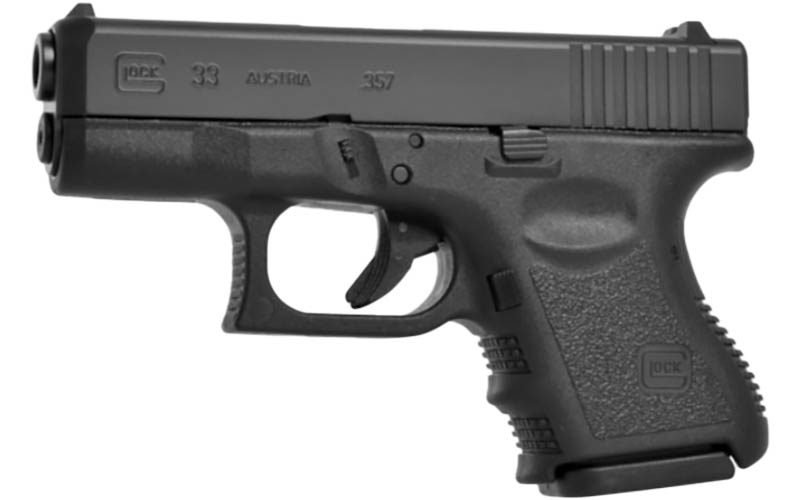
The other calibers available in a Glock 26-like configuration are the Glock 27 in .40 S&W, Glock 33 in .357 Sig and Glock 39 in .45 GAP.
The Glock 27 and 33 are also available with or without Glock’s modular backstrap system (Gen 4 and Gen 5), but the Glock 39 is only offered with the standard grip (Gen 3).
Both the Glock 27 and 33 have a 9+1 standard capacity, but the G39 is a 6+1 single-stack.
The Big-Bore Subcompacts
Glock 30
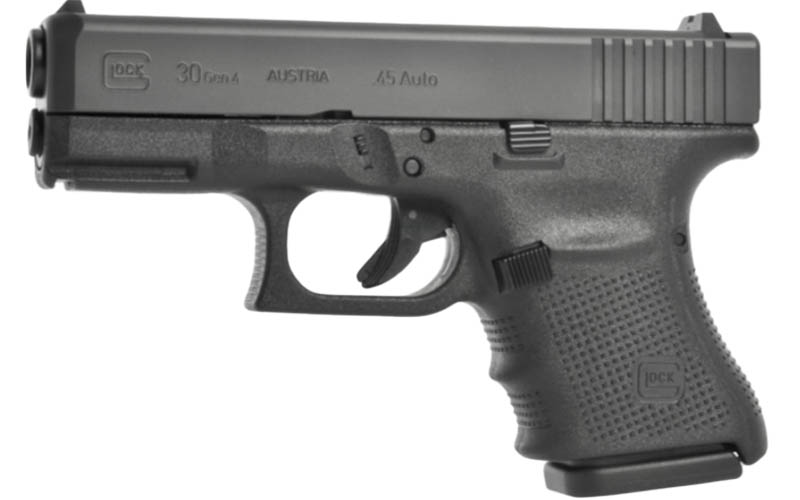
The Glock 30 in .45 ACP is offered with a standard frame or as the 30S and 30SF variants. All three share the same internal parts and a 3.78-inch barrel, but the 30SF (short frame) has a reduced backstrap radius and the 30S has the same SF frame plus a slimmer (1-inch vs 1.12-inch) slide.
Glock 29
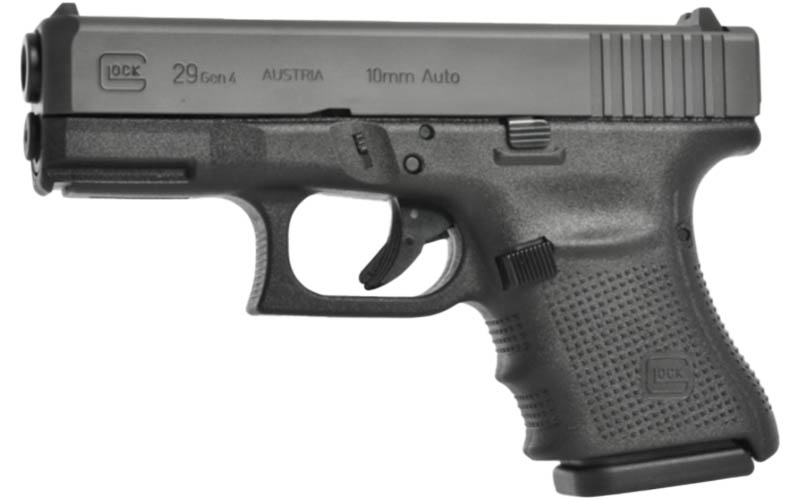
The Glock 29 in 10mm Auto is available either with a standard frame in a Gen 4 configuration or with a short frame in a Gen 3 configuration as the Glock 29SF.
Glock 36
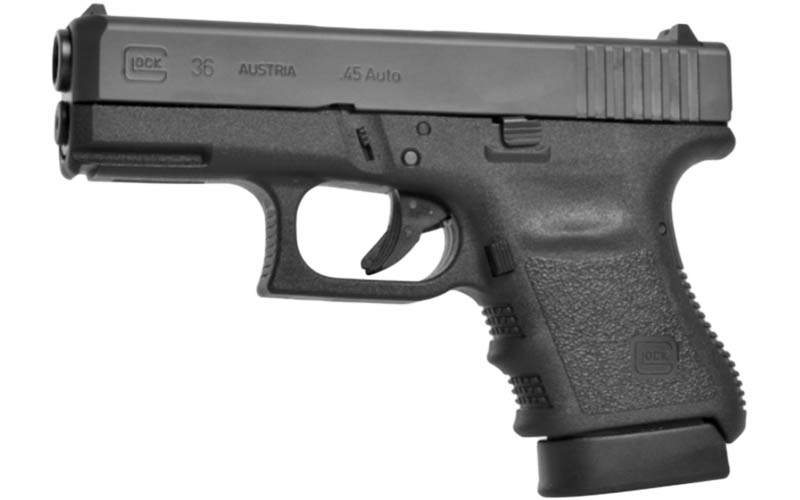
The Glock 36, first released in 2000, is a single-stack subcompact in .45 ACP and uses the same upper as the Glock 30S. With its slimmer single-stack frame, capacity is reduced from 10 rounds of .45 ACP to 6.
The G29, G30 and G36 also all feature a railed frame for mounting a weapon light or laser.
.380 Baby Glocks
Glock 28
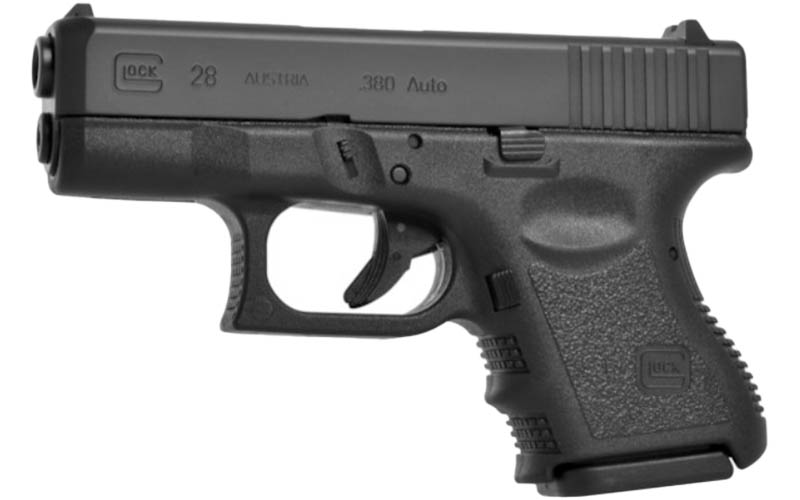
The G28 was the first .380 Glock, but due to the 1968 GCA, Glock 28 pistols cannot be normally imported and are therefore quite rare. They have been imported in small numbers for law enforcement, however, meaning that they can occasionally be found on the secondhand market. It also differentiates itself from other Glocks by using a straight blowback action rather than a short recoil design.
Glock 42
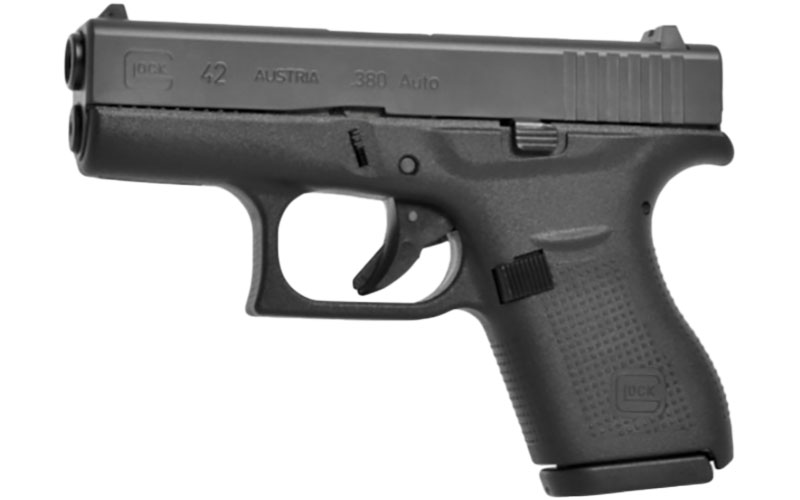
The Glock 42, however, is made in the United States and is therefore widely available. It’s a slim, subcompact single-stack in .380 ACP. It has a 3.25-inch barrel and standard capacity of 6+1 with the same short recoil operation as all other Glocks (as opposed to the straight blowback design and 10-round capacity of the G28).
Glock Generations
Gen 3 Glock pistols have been in production since 1991; unless you're old enough to remember the very first Glocks, Gen 3 is the version that you know. Gen 4 pistols are very similar to Gen 3 but also have the Glock Modular Backstrap System.
The Gen 5 guns have revised internals (a new trigger group with one less trigger pin), the Glock Modular Backstrap System and slightly beefed-up frames and slides to house the new Glock Marksman Barrel. The new barrels also now have traditional rifling rather than polygonal. Some Gen 5 pistols (but not all!) are also offered in MOS configuration with an optics-ready slide.
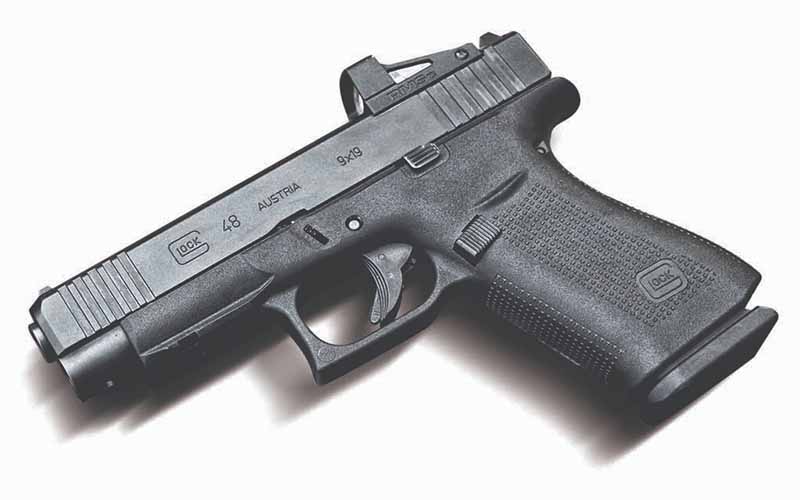
The Glock 43X/43X MOS (and the Glock 48 and 48 MOS, which have a 4.2-inch barrel but the same frame) are somewhere between a Gen 4 and Gen 5 pistol. They have Gen 5 trigger components, the Glock Marksman Barrel and front cocking serrations (a Gen 5 feature).
What's The Best Baby Glock For Concealed Carry?
Just as with selecting any other firearm, which specific baby Glock model will prove best for you is highly dependent on your individual needs. With as popular as Glocks are and the wide variety of models available, at least one of them will likely suit you well. Just keep in mind that when it comes to firearms design, there’s no getting away from tradeoffs.
Due to its smaller size, the Glock 26 will always be snappier than a Glock 19, but the recoil can be tamed some with an extended magazine for a better grip. Even with a 12-round extended magazine, the 26 can still be easily concealed and carried.
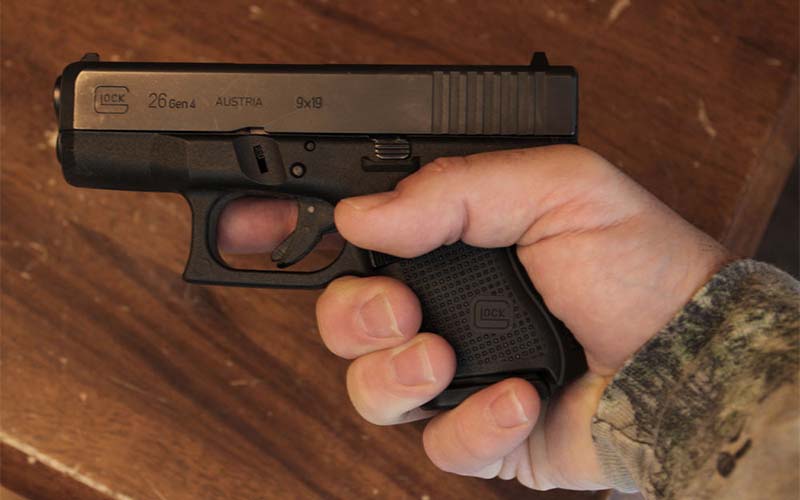
Some consider the G26 a bit heavy and fat for a subcompact, but it’s still manageable for most. While it may not be the smallest of the available baby Glocks, it more than makes up for it in power, capacity and shootability.
The Glock 27 is a right handful to shoot in .40 S&W, and you’ll likely go broke trying to feed a G33 in .357 Sig or a G39 in .45 GAP . Unless you have a very compelling reason, these models frankly aren't worth considering in 2022.
Among the big-bore baby Glocks, both the Glock 29 and Glock 30 are sensible if paired with the right ammunition (i.e., nothing too powerful given the guns’ light weights). They're big enough to be controllable but remain small enough to conceal, a rarity among big-bore pistols.
Frankly, the Glock 36 is hardly any lighter or slimmer (0.2 inches narrower overall) than a Glock 30 and holds four fewer rounds in the magazine. This means that unless those extra .2 inches make or break your ability to conceal it, the G36 is the wiser option for most.
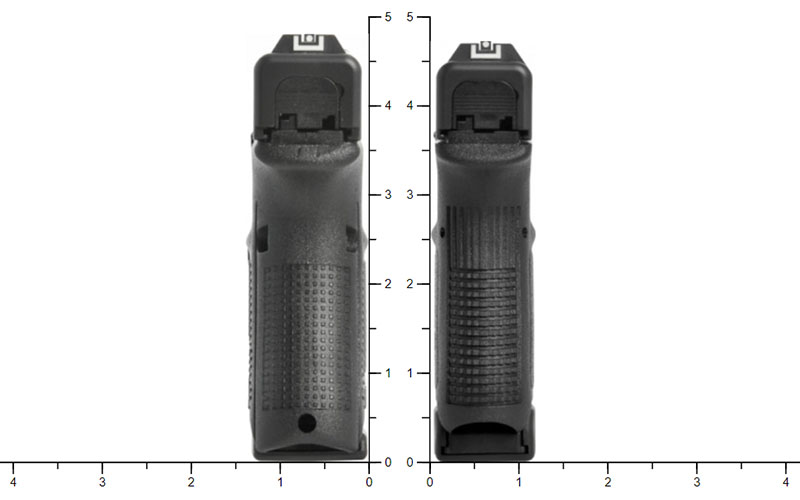
Of the Slimline series guns, the Glock 42 in .380 is more controllable than the G43 in 9mm and may be the smarter buy because of it. The extra barrel length (3.2 inches) compared to most pocket .380 pistols improves the terminal performance from marginal to tenable in most testing. Even ignoring ballistics, most people will be able to shoot a G42 better than a G43, and shot placement always trumps ballistics in defensive shootings.
The Glock 43 may be a wickedly easy gun to conceal and carry, but it’s snappy in recoil. It makes a good choice for deep concealment or as a backup gun in an ankle holster, but it will be up to you to determine if the increased efficacy of 9mm is worth the extra recoil.
The Glock 43X is considered the shooter's Glock subcompact, with a fuller grip and improved trigger. While the 10-round capacity rankles some given the size of the gun (it's the same height as a Glock 19), Shield Arms' S15 15-round flush-fit magazines can change that equation (though possibly at the expense of reliability).
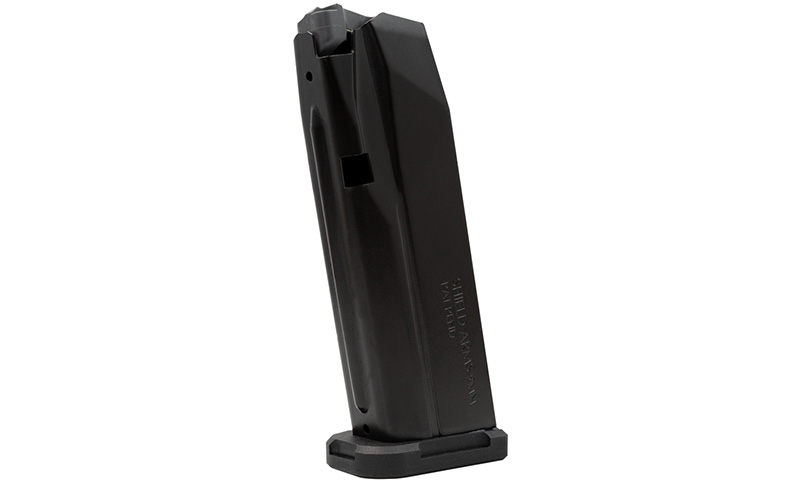
So…which is best? As you can see, it depends on your needs and preferences. The Glock 26 and 43X are arguably the best all-rounders, but the 43 is a little easier to conceal and carry at the expense of capacity and shootability. While many disparage .380 ACP as a defensive cartridge, don’t write it off entirely, as a G42 still offers incredible firepower for its size. The big-bore options exist as well for those who prefer them, but frankly aren’t a good choice for most concealed carriers given the efficacy of available 9mm defensive ammo today.
Glock Talk: Discover More Tips & Reviews
- Why Are Glocks So Popular?
- Glock Upgrades – Customizing for Performance
- Glock 19 Review: 9mm Double Stack Glock
- Glock 43 Review – Test Driving the Single-Stack 9mm
- Is Glock 26 Good for Concealed Carry?
- Glock 34 Review – What Makes The Glock 34 A Top Competitor?
- Best Glock Pistols For Any Application
- Glock 30S Review – Is the G30S Good for Concealed Carry
- What are the Best 10mm Glock Options?
- Glock 43X Weight Loaded
Subcompact Glocks Vs. Similar Pistols
Besides brand recognition and consistent quality, the other advantage that any Glock pistol has is aftermarket support. Holsters, magazines, sights…you name it, it’s available for Glocks.
In recent years, however, the subcompact 9mm market has been taken over by the double-stack micro pistols. The Sig P365, Springfield Hellcat, S&W Shield Plus, Ruger MAX 9 and others are all about the same size as the G43 but have 10+1 capacity or better.
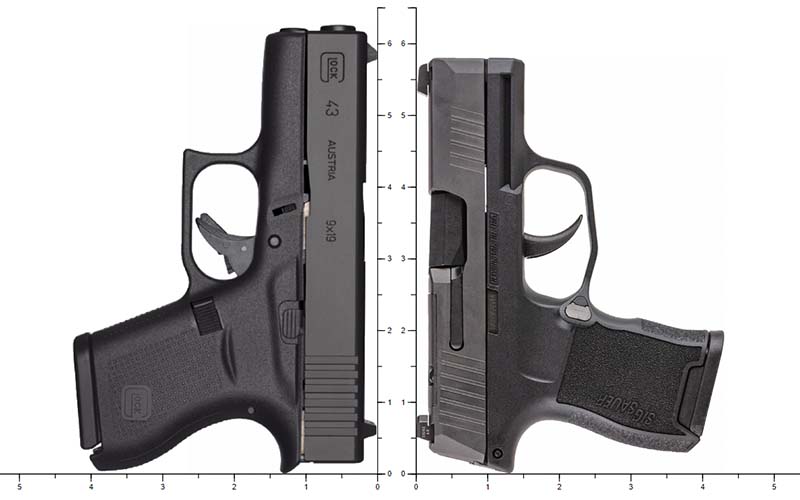
Almost all of these pistols are available optics-ready from their respective manufacturers as well, while the only Glock subcompact offered optics-ready from the factory is the 43X MOS.
Sig Sauer has even created the P365X, a P365 upper on the XL frame for fuller purchase and a 12+1 standard capacity. Sig also has a version in .380, and Ruger produces the LCP MAX with a 10+1 capacity in .380 as well.
The Glock 26 is known to be a little gentler to shoot than these non-Glock double-stack micros (all of which are snappy), but not so much that it’s a critical difference.
As mentioned, Shield Arms S15 magazines can give the 43X a 15+1 capacity, but reliability is a mixed bag. A lot of people have no issues with them, but others do even with the Shield Arms mag catch and extra power magazine springs. For those who experience no problems with them, it’s a game-changing upgrade for the 43X, but should be approached with caution given the potential hit to reliability.
For those specifically interested in a big-bore subcompact, a Glock makes even more sense since the only comparable pistol is Smith & Wesson’s M&P45 Shield.

Despite there now being many pistols of similar design and quality offered by other manufacturers, any baby Glock chambered for a viable defensive cartridge will still make a great carry gun in 2022. When selecting which model is best for you, size, capacity and caliber are all important considerations that should impact your decision. Ultimately, however, Glocks still have an edge over the newcomers in terms of time-tested reliability and aftermarket support.
More Glock Reviews:
- Glock Review
- Glock 44 Review
- Glock 19 Review
- Glock 43 Review
- Glock 17 Review
- Glock 26 Review
- Glock 42 Review
- Glock 34 Review
- Glock 22 Review
- Glock 40 Review
- Glock 20 Review
- Glock 30 Review
- Glock 41 Review
- Glock 29 Review
- Glock 43X Review

Next Step: Get your FREE Printable Target Pack
Enhance your shooting precision with our 62 MOA Targets, perfect for rifles and handguns. Crafted in collaboration with Storm Tactical for accuracy and versatility.
Subscribe to the Gun Digest email newsletter and get your downloadable target pack sent straight to your inbox. Stay updated with the latest firearms info in the industry.

![Best Concealed Carry Guns In 2025 [Field Tested] Wilson Combat EDC X9S 1](https://gundigest.com/wp-content/uploads/Wilson-Combat-EDC-X9S-1-324x160.jpg)


![Best 9mm Carbine: Affordable PCCs [Tested] Ruger Carbine Shooting](https://gundigest.com/wp-content/uploads/Ruger-Carbine-Shooting-100x70.jpg)
![Best AR-15: Top Options Available Today [Field Tested] Harrington and Richardson PSA XM177E2 feature](https://gundigest.com/wp-content/uploads/Harrington-and-Richardson-PSA-XM177E2-feature-100x70.jpg)
